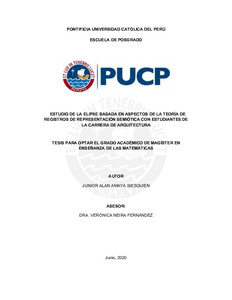| dc.contributor.advisor | Neira Fernández, Verónica | |
| dc.contributor.author | Amaya Siesquien, Junior Alan | |
| dc.date.accessioned | 2020-10-13T17:57:12Z | |
| dc.date.available | 2020-10-13T17:57:12Z | |
| dc.date.created | 2020 | |
| dc.date.issued | 2020-10-13 | |
| dc.identifier.uri | http://hdl.handle.net/20.500.12404/17249 | |
| dc.description.abstract | El presente trabajo tiene como objetivo analizar la manera en que los estudiantes de la carrera
de Arquitectura movilizan la noción de Elipse cuando resuelven una actividad didáctica que
requiera el uso de registros de representación semiótica. La investigación se lleva a cabo en
una universidad privada de Lima con estudiantes del primer ciclo de la carrera de Arquitectura,
cuyas edades oscilan entre los 16 y 18 años. Los sujetos de estudio, mediante una serie de
preguntas, deben movilizar sus conocimientos acerca de los elementos de la Elipse haciendo
uso de los registros de representación de lengua natural, algebraico y gráfico. En relación a
eso, se plantea responder la siguiente pregunta de investigación: ¿Cómo los estudiantes de
la carrera de Arquitectura movilizan la noción de Elipse al resolver una actividad didáctica que
requiere el uso de registros de lengua natural, algebraico y gráfico? Para ello, se proponen
como objetivos específicos: Identificar y describir los tratamientos y las conversiones que los
estudiantes utilizan cuando resuelven una actividad didáctica sobre la Elipse. Por otro lado,
justificamos la presente investigación debido a la importancia que tiene el estudio de la Elipse
para estudiantes de la carrera de Arquitectura en su formación académica y profesional. Para
sustentar nuestra investigación, tomamos aspectos de la Teoría de Registros de
Representación Semiótica, en lo que se refiere a tratamientos y conversiones. También,
debido a que parte del enfoque de nuestra investigación es describir comportamientos,
opiniones, actitudes e interacciones del estudiante cuando resuelve una actividad didáctica,
consideramos, como metodología, la investigación cualitativa. Con respecto a los resultados,
muestran que los estudiantes logran movilizar sus conocimientos referentes a la Elipse
haciendo uso de los registros de Representación Semiótica, lo cual permite entender que se
apropiaron de la noción de Elipse en sus diferentes representaciones. Finalmente, una de las
recomendaciones de este trabajo de investigación es la de realizar estudios de textos
universitarios en nuestro país para mejorar la enseñanza de la Elipse y las cónicas en general,
ya que este tema es visto en los primeros ciclos de la mayoría de carreras universitarias. | es_ES |
| dc.description.abstract | The present work aims to analyze the way in which the students of the Architecture career
mobilize the notion of Ellipse, when they solve a didactic activity that requires the use of
registers of semiotic representation. The research is carried out at a private university in Lima
with students from the first cycle of the Architecture career, whose ages range from 16 to 18
years. The subjects of study by means of a series of questions must mobilize their knowledge
about the elements of the ellipse making use of the registers of representation of natural,
algebraic and graphic language. In relation to this, it is proposed to answer the following
research question: How do students from the Architecture career mobilize the notion of Ellipse,
when solving a didactic activity that requires the use of natural, algebraic and graphic language
registers? For this, the following specific objectives are proposed: Identify and describe the
treatments and conversions that students use when they solve a didactic activity on the Ellipse.
On the other hand, we justify this research due to the importance of the study of the Ellipse for
students of the Architecture career in their academic and professional training. To support our
research we take aspects of the Theory of Records of Semiotic Representation, in what refers
to treatments and conversions. Also, because part of the focus of our research is to describe
student behaviors, opinions, attitudes and interactions when solving a didactic activity, we
consider qualitative research as a methodology. With respect to the results, they show that the
students manage to mobilize their knowledge regarding the Ellipse using the Semiotic
Representation registers, which allows us to understand that they appropriated the notion of
ellipse in their different representations. Finally, one of the recommendations of this research
work is to carry out university text studies in our country to improve the teaching of the ellipse
and conics in general, since this topic is seen in the first cycles of most careers. university. | es_ES |
| dc.language.iso | spa | es_ES |
| dc.publisher | Pontificia Universidad Católica del Perú | es_ES |
| dc.rights | Atribución 2.5 Perú | * |
| dc.rights | info:eu-repo/semantics/openAccess | es_ES |
| dc.rights.uri | http://creativecommons.org/licenses/by/2.5/pe/ | * |
| dc.subject | Arquitectura--Estudio y enseñanza | es_ES |
| dc.subject | Geometría--Estudio y enseñanza (Superior) | es_ES |
| dc.subject | Matemáticas--Estudio y enseñanza (Superior) | es_ES |
| dc.title | Estudio de la elipse basada en aspectos de la teoría de registros de representación semiótica con estudiantes de la carrera de Arquitectura | es_ES |
| dc.type | info:eu-repo/semantics/masterThesis | es_ES |
| thesis.degree.name | Magíster en Enseñanza de las Matemáticas | es_ES |
| thesis.degree.level | Maestría | es_ES |
| thesis.degree.grantor | Pontificia Universidad Católica del Perú. Escuela de Posgrado | es_ES |
| thesis.degree.discipline | Enseñanza de las Matemáticas | es_ES |
| renati.advisor.orcid | https://orcid.org/0000-0002-2540-3530 | es_ES |
| renati.discipline | 199117 | es_ES |
| renati.level | https://purl.org/pe-repo/renati/level#maestro | es_ES |
| renati.type | http://purl.org/pe-repo/renati/type#tesis | es_ES |
| dc.publisher.country | PE | es_ES |
| dc.subject.ocde | https://purl.org/pe-repo/ocde/ford#5.03.01 | es_ES |






